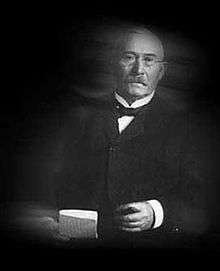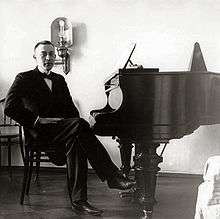Blüthner
 | |
| Private | |
| Industry | Musical instruments |
| Founded | 1853 |
| Founder | Julius Blüthner |
| Headquarters | Großpösna near Leipzig, Germany |
Key people | Dr. Christian Blüthner-Haessler (CEO) |
| Products | Grand pianos and upright pianos |
| Website | bluethner.de |
Julius Blüthner Pianofortefabrik GmbH, is a piano-manufacturing company in Leipzig Germany.[1] Along with C. Bechstein, Bösendorfer and Steinway & Sons, Blüthner is frequently referred to as one of the "Big Four" piano manufacturers.[2][3][4]
History

Julius Blüthner established his workshop in Leipzig, Saxony in 1853. This accomplishment was only achieved after a long and difficult campaign to gain Leipzig citizenship. Julius started his endeavor with himself and three other craftsman. A deeply religious man, Julius spoke the defining words that would allow his company to survive and flourish for the next 162 years, "May God Prevail". The age of any particular Blüthner piano can be determined by matching its serial number to the age table freely available on the Blüthner website.[5]
By 1900 Blüthner had become the largest piano maker in Germany, producing some 5,000 instruments annually. Innovations such as the Aliquot string, a fourth string that vibrated sympathetically and that is tuned in unison as well as the cylindrical soundboard and angle cut hammers, created a unique voice for the Blüthner instrument.
The owners Adolf Max Blüthner, Dr. Paul Robert and Willy Bruno Heinrich were awarded an imperial and royal warrant of appointment to the court of Austria-Hungary.[6]
Models

Today Blüthner grand pianos come in six different sizes. The company also makes several sizes of upright pianos. Custom-ordered pianos can be produced with almost any style cabinet and veneers. It also makes several models of Haessler pianos and two lines of Irmler pianos in its German factory.
Model 1: Concert Grand - 9'2" (280 cm)
Model 2: Small Concert Grand - 7'8" (238 cm)
Model 4: 6'10" (210 cm)
Model 6: 6'3" (191 cm)
Model 10: 5'5" (166 cm)
Model 11: 5'1" (154 cm)
Designer models
The one-of-a-kind Blüthner piano of particular interest was a special lightweight instrument, made for use on the Zeppelin LZ 129 Hindenburg. The piano had its harp plate made of aluminum, that saved about 100 kg of weight versus a regular cast iron plate of the same size piano. This was the first piano used in flight, and it was used in an "air-concert" radio broadcast.[7] It was removed in 1937 to save weight so it survived the Hindenburg's infamous crash, only to be destroyed by bombing during WWII.[8] A replica of this piano was featured in the 1975 film The Hindenburg where Reed Channing (Peter Donat) sings. Since the film is set during the airship's final flight, during which the piano was not on the ship, the piano's presence is a historical error.[9]
Blüthner makes a few specialized pianos including some with the design reversed so that a left-handed person can play the tenor with his left hand and the bass with his right hand. In 2008 they designed and built a special keyboard for a customer in Spain which had the Jankó keyboard design.
Notable Blüthner artists

Numerous royals, composers, conductors, artists, authors and performers have owned Blüthner pianos. They include Willhelm II, Emperor Franz Joseph I, Johannes Brahms, Gustav Mahler, Liberace, Béla Bartók, Claude Debussy, George Formby, Dodie Smith, Max Reger, Richard Wagner, Johann Strauss, Pyotr Ilyich Tchaikovsky, Dmitri Shostakovich, Petronel Malan. [11] Sergei Rachmaninoff commented that "There are only two things which I took with me on my way to America...my wife and my precious Blüthner".[10]
In 2012 American pianist Pierce Kagari Emata recorded a CD of eclectic works, "From the Hands to the Heart," on a Blüthner Model 1, which included the recording world premiere of Cuban-American composer Michael Dalmau Colina's Sestina Mutations.
In 2017 Indonesian pianist and composer Ananda Sukarlan recorded a CD of his own music with a Blüthner. This CD, "Love & Variations" consists of his piano solo works and works for voice and piano, sung by soprano Mariska Setiawan.
Blüthners have been used in popular music, as well. One Blüthner piano owned by the Abbey Road Studios in London was used on some tracks of The Beatles' Let It Be (1970) album, most notably, in the hits "Let It Be" and "The Long and Winding Road". Blüthners were also used in the films Gaslight (1944) and The Sting (1973)[12], and one was played by Hannibal Lecter in the movie Hannibal. Another, a stunt piano, was destroyed in Iron Man (2008). A Blüthner piano also appears in the 2004 Cole Porter biopic De-Lovely in the Venice apartment scenes.
References
- ↑ "Blüthner", Grove Music Online, 2009. Accessed 14 April 2009.
- ↑ "Restoration". Courtney Pianos Ltd. Retrieved 6 February 2017.
- ↑ "Bluthner Pianos at The Piano Shop Bath". The Piano Shop Bath. 10 May 2013. Retrieved 6 February 2017.
- ↑ "About Us". Henderson Pianos Sydney Australia. Retrieved 6 February 2017.
- ↑ "Table of Blüthner Serial Numbers". Blüthner UK. Retrieved 6 February 2017.
- ↑ "Handbuch des Allerhöchsten Hofes und des Hofstaates Seiner K. und K. Apostolischen Majestät". Vienna: K.k. Hof- und Staatsdruckerei. 1917. p. 519. Retrieved 6 February 2017.
- ↑ "History" Archived July 24, 2008, at the Wayback Machine., Blüthner UK Website, 2005. Accessed 14 April 2009.
- ↑ Grossman, Dan (June 25, 2010). "The Hindenburg's Aluminum Piano". Airships.net.
- ↑ Grossman, Dan (June 10, 2010). ""The Hindenburg" (1975): Fact & Fiction". Airships.net.
- 1 2
- ↑ "Personalities" Archived 2008-07-24 at the Wayback Machine., Blüthner UK Website, 2005. Accessed 14 April 2009.
- ↑ In an interview included on the 2012 Universal Pictures Home Entertainment DVD release of The Sting (1973), Marvin Hamlisch states: "... I didn't want to use a 'honky-tonk' piano at all. But I wanted to use a very sweet-sounding piano and I used a Blüthner. So I didn't go for the dynamics, let's say, of a Bosendorfer or a Steinway. I went for a more quiet sound."
External links
| Wikimedia Commons has media related to Julius Blüthner Pianofortefabrik. |